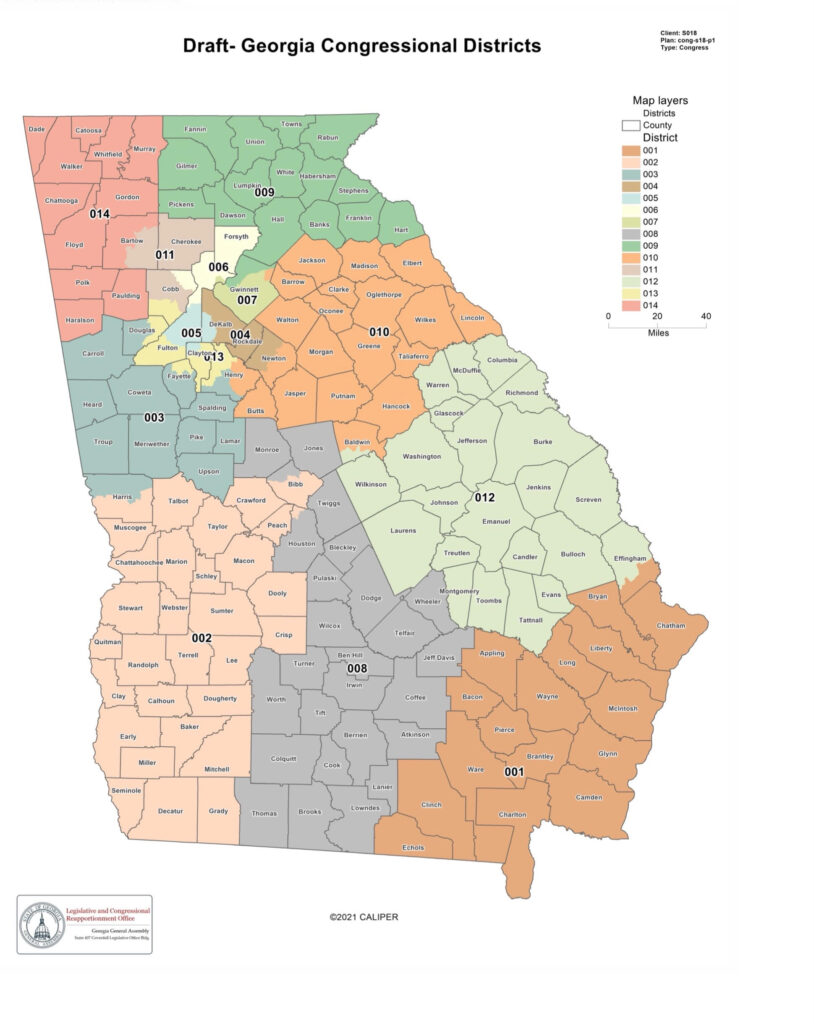
ATLANTA – Georgia lawmakers will converge at the state Capitol Nov. 3 to begin redrawing Georgia’s political maps, a once-a-decade exercise to accommodate population shifts reflected in the U.S. Census.
Democrats and Republicans are offering vastly different visions for how Georgia should be represented in Congress, with Republicans seeking to maintain their majority in the Peach State’s 14-member U.S. House delegation and Democrats looking to even things up.
“Expect a lot of rhetoric,” Lt. Gov. Geoff Duncan told Capitol Beat. “I expect both good and bad ideas to echo throughout the halls. There will obviously be disagreements from people all across the state, but we will follow the letter of the law.”
This is Duncan’s first reapportionment session as the state Senate’s presiding officer.
>> Two maps, two visions: Georgia’s balance of power for next decade hangs in the balance
“I was a product of reapportionment when I was elected to a newly drawn [Georgia House] district,” said Duncan, a former state representative who is not running for a second term as lieutenant governor. “I’ve told my staff to become experts on the rules and the law so we execute the process properly.”
Georgia House and Senate Democrats released a proposed congressional map last month. Democrats said their map would provide a fair opportunity for voters of color in Georgia to elect representatives of their choice, as minorities would make up a majority of the residents in six of the 14 districts (Districts 2, 4, 5, 7, 10, and 13).
But with Republicans in control of the General Assembly, any map Democrats suggest – whether a congressional map or proposed boundaries for state House and Senate districts – promises to be dead on arrival.
For the GOP, the key question will be whether to try to regain one of the two congressional seats in Atlanta’s northern suburbs lost to the Democrats during the last two election cycles or go for broke and try to take back both seats.
A congressional map Georgia Senate Republicans released in late September appears to take the more cautious approach. It goes after the 6th Congressional District seat Rep. Lucy McBath, D-Marietta, won in 2018 by moving heavily Republican Forsyth County into the district and removing more Democrat-friendly North DeKalb County.
Earlier this month, the Princeton Gerrymandering Project, along with RepresentUs, a nonpartisan anti-corruption organization, gave the GOP map a “C” on its Redistricting Report Card, based on partisan fairness, competitiveness and geographic features. The organization said its “C” grade means the proposed map is average, and could be better but also worse.
The same report card gave the Democrats’ map a “B” for partisan fairness and said the map would give a slight partisan advantage to Democrats. It also gave the Democratic map two “C’s” for competitiveness and geographic features.
RepresentUS recently ranked Georgia as one of 35 states that are most at-risk for partisan gerrymandering. The organization said risks are high because new election maps can be controlled and drawn by politicians in secret and rigged for partisan gain. It also said so-called “rigged” election maps are hard to challenge in court.
Democrats say their map is likely to lead to a 7-7 split in Georgia’s congressional delegation. Currently, there are eight Republicans in Congress representing Georgia and six Democrats.
The GOP map was overseen by Duncan and state Sen. John Kennedy, R-Macon, who chairs the Senate Reapportionment and Redistricting Committee.
At the state legislative level, Democrats on Friday released their own map that redraws the state’s 180 House districts. Submitted by House Minority Leader James Beverly, D-Macon, Democrats said the map would improve representation of urban and suburban residents and non-white Georgia voters.
Last week, the Georgia Senate Democratic Caucus released its proposed legislative district map.
The proposal contains 22 districts in which minorities are a majority of residents and a majority of the voting age population, an increase from the 20 such districts currently.
In a statement, Democrats said the new map more fairly represents the partisan makeup of Georgia’s electorate by establishing 25 districts that likely would elect Democrats, 27 that probably would elect Republicans, and four competitive districts. Currently, Republicans hold 34 of the state Senate’s 56 seats.
This story is available through a news partnership with Capitol Beat News Service, a project of the Georgia Press Educational Foundation.